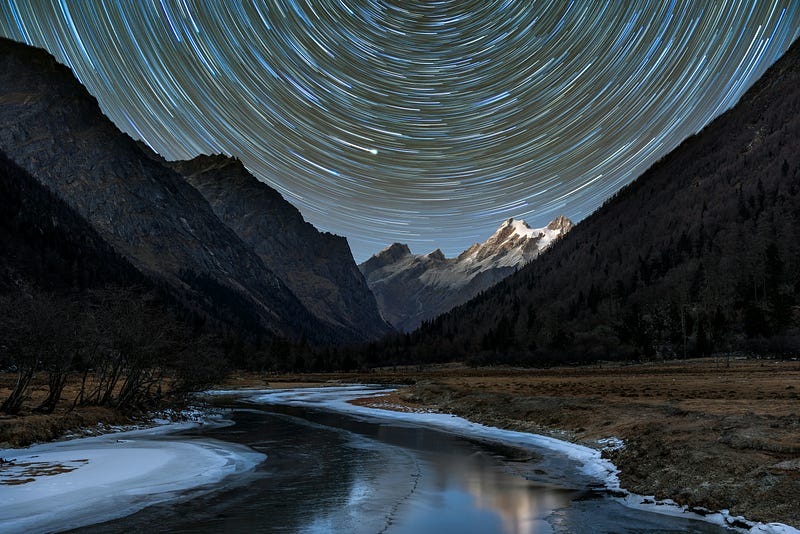Nature's Endless Patterns: Discovering Fractals and Self-Similarity
Written on
Chapter 1: The Allure of Nature’s Patterns
Have you ever observed that staring at a section of a tree can evoke the entire tree's image? Similarly, the intricate underground root networks mirror the branches above ground. This is akin to experiencing a sense of déjà vu in nature. It’s intriguing how elements like lightning bolts, rivers, and even broccoli seem to participate in a cosmic joke of similarity. What accounts for this resemblance?
The Enigma of Self-Similarity
Once you start noticing these patterns, they appear everywhere—trees, rivers, lightning, and even cracks in ceilings. It seems the universe has a peculiar designer fixated on repetition. This phenomenon, where a part resembles the whole, is termed self-similarity. Picture those triangles filled with smaller triangles or shapes that persistently reflect themselves.
The mathematician Benoît Mandelbrot coined the term "fractal" to describe these self-repeating forms. While it may sound complex, fractals are quite fascinating. They are shapes that replicate their patterns regardless of the scale—zoom in or out, and the pattern remains intact. Fractals exist in a dimension that challenges our traditional understanding of geometry.
Understanding Dimensions: A Mathematical Perspective

As we navigate our everyday lives, we often conceive dimensions as one-dimensional lines, two-dimensional shapes, and three-dimensional objects. However, Mandelbrot offered a unique perspective on dimensionality and how shapes occupy space when growing or shrinking.
For instance, if you double the length of a line, the line's length doubles. Doubling a square results in four times the area, while doubling a cube gives you eight times the volume. Yet fractals defy these expectations. When scaled, a fractal might yield unexpected increases. Therefore, rather than being confined to neat whole numbers, fractals inhabit the domain of fractional dimensions—like 1.585 dimensions, to be precise. It's akin to cramming an infinite number of jigsaw pieces into a limited space.
Fractals in Nature: The Efficient Design
You might wonder why nature embraces fractals so eagerly. The answer lies in their efficiency. Trees, for instance, are not just one species but encompass various plants that share similarities in their fractal branching patterns. This design allows them to maximize surface area for sunlight and CO2 absorption without becoming overly massive.
Roots exhibit similar fractal patterns, enhancing their surface area for water and nutrient absorption. Remarkably, our lungs and blood vessels also utilize fractal systems. Lungs employ fractal branching to maximize surface area for oxygen exchange, while our circulatory system efficiently distributes blood without causing chaos.
Fractals Beyond Living Organisms

Fractals extend beyond living entities; they manifest in numerous non-living structures as well. For example, rivers display fractal branches as they flow toward the sea, efficiently distributing water and sediment. Similarly, cracks and lightning bolts follow fractal patterns to effectively dissipate energy. Scientists studying these patterns have discovered that they exist in those elusive "in-between" dimensions, much like mathematical fractals.
The Nature of Fractals: Diverse Rules and Solutions
You might assume there's a universal principle governing every fractal pattern. However, nature's complexity is far from straightforward. Fractals can be found in crystals, snowflakes, and unusual mineral formations, each with its own set of rules shaped by temperature, humidity, and chemical composition.
One remarkable aspect of fractals is that they lack a singular genetic blueprint or guiding law. Each system has evolved independently, utilizing fractals as efficient solutions to its unique challenges. It appears that nature conveys a powerful message: the simplest solutions often prove to be the most effective.
As you gaze upon a tree, a lightning bolt, or even a piece of broccoli, remember that you’re witnessing not just random shapes, but nature’s extraordinary artistry at work.
Chapter 2: The Magic of Fractals in Nature
This video, titled "Infinite Patterns," delves into the captivating world of fractals and self-similarity, exploring how these patterns are omnipresent in nature.
In the second video, "Patterns in Nature - Symmetry, Fractals & Geometry!", viewers will discover the intricate relationships between symmetry, fractals, and geometry in the natural world.